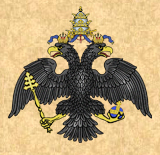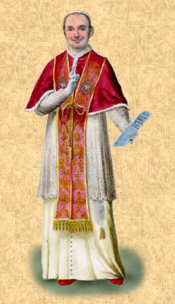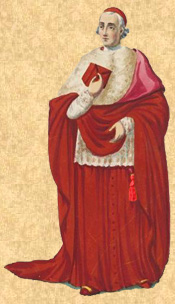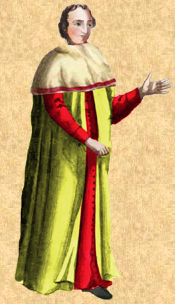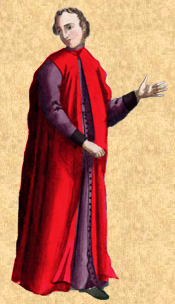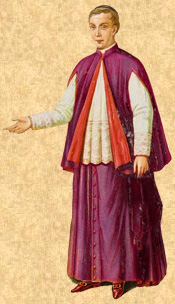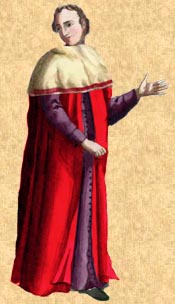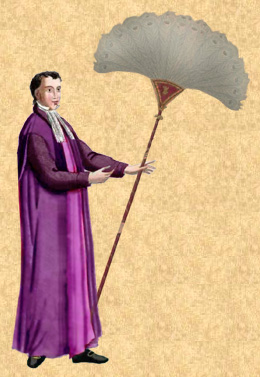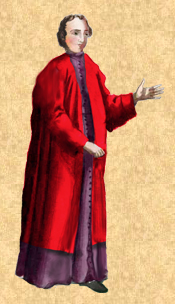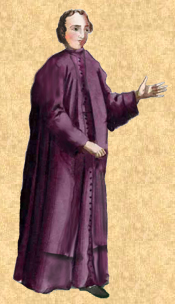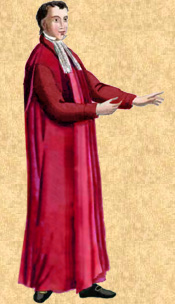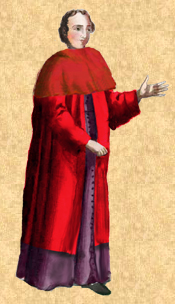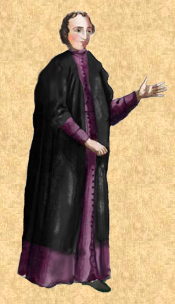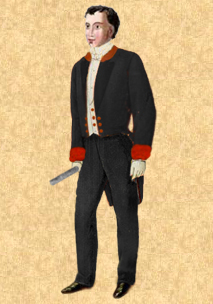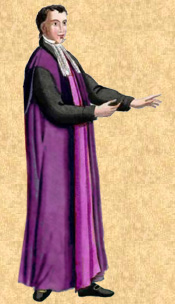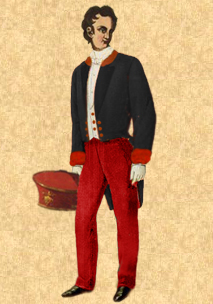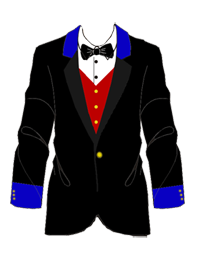|
HABITS
AND UNIFORMS OF THE PATRIARCHAL CURIA AND PONTIFICAL COURT General Definitions: Cappa Magna: A large cape with train and a fur hood (winter) or silk hood (summer). Worn by bishops and canons. Mozzetta: An elbow-length shoulder cape. Worn by bishops and certain other officials. Mantelletta: A sleeveless knee-length garment closed at the neck and open in the front with two large lapels. Worn by canons. Mantellone: A sleeveless full-length garment closed at the neck and open in the front with two large lapels. Toga: A mid-calf garment with full-length sleeves, usually worn open in the front. In addition to their use here, clergy of the Imperial Roman Church may wear the toga appropriate to their grade with house dress in place of a ferraiolo.
The Prince-Bishop of Rome-Ruthenia
(audience habit)
Patriarchal
Chamberlains of Honour and Lay Officers of the Nobile Anticamera Segreta
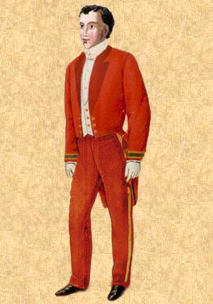 Civil Uniform of the Patriarchal Grooms Scarlet uniform of the Nobles of the Anticamera with red trousers.
Civil
Uniform of the Lay Private Chaplains of HHE & the Chief Usher
Service Uniform The service uniform is black with black trousers, gold buttons, 4 inch red cuffs, red collar, and red waistcoat with gold buttons. The tie is black, four-in-hand, or else for black-tie evening use, a black bow tie. The Nobles of the Anticamera add two stripes of one-half inch wide gold lace on the cuffs, evenly spaced. Those entitled to the diplomatic uniform instead have one stripe of oak leaves centred on the cuff. The Nobles of the Anticamera and those entitled to the diplomatic uniform use black trousers with gold lace. Diplomatic Uniform
The
diplomatic uniform is identical to that of the Nobles of the
Anticamera with the following modifications:
The
diplomatic uniform is authorised for the following officials: In all of the above, clerics use the same form, except that the buttons are the same as on their cassock, Roman-Ruthenian Household Uniform Authorised for the Grand Dukes of Rome. The regular version is identical to the service uniform, except that the collar and cuffs are royal blue, and there is no gold lace. For laity, there are four gold buttons on the cuff, and a gold button at the base of the lapels. For clergy, there are five buttons on each cuff, as well as one on each side at the base of the lapel. Those buttons are in black, purple, or red according to the buttons used on the waistcoat. The black trousers are without gold lace. Clergy use the standard form of the uniform, however, with the cloth buttons on the jacket as usual and matching cloth buttons on the red waistcoat - black in general, Roman purple for bishops and other prelates so entitled, scarlet for cardinals and other prelates so entitled, and white for the Bishop of Rome-Ruthenia.The full dress version is idential to the service version, except that a black tailcoat with royal blue collar and cuffs is used, with cuff but-tons identical to those of the regular jacket. Also, three buttons of the same style as used with the regular jacket are placed along the inside edge of the coat under the lapels, and two on the back as usual. No other buttons are used. The waistcoat is the same as used for the regular uniform. Clergy may equally use the standard form of the uniform, however, with the cloth buttons on the jacket as usual, but the buttons on the white three-button waistcoat are always white.
[Curia] DISCLAIMER, LEGAL, AND COPYRIGHT NOTICES
|
